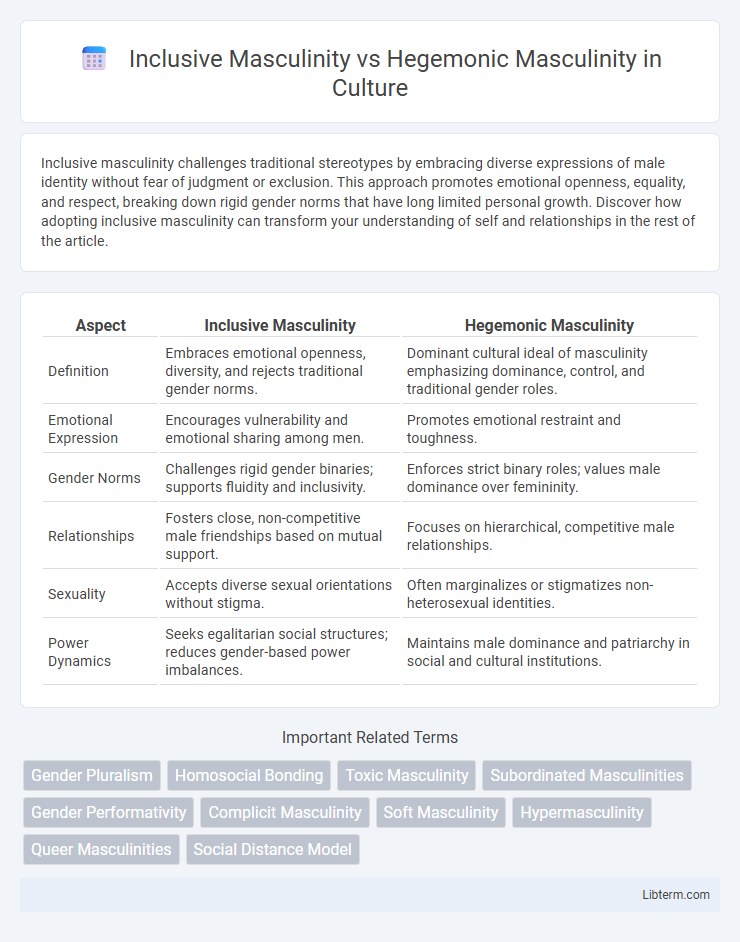Inclusive masculinity challenges traditional stereotypes by embracing diverse expressions of male identity without fear of judgment or exclusion. This approach promotes emotional openness, equality, and respect, breaking down rigid gender norms that have long limited personal growth. Discover how adopting inclusive masculinity can transform your understanding of self and relationships in the rest of the article.
Table of Comparison
| Aspect | Inclusive Masculinity | Hegemonic Masculinity |
|---|---|---|
| Definition | Embraces emotional openness, diversity, and rejects traditional gender norms. | Dominant cultural ideal of masculinity emphasizing dominance, control, and traditional gender roles. |
| Emotional Expression | Encourages vulnerability and emotional sharing among men. | Promotes emotional restraint and toughness. |
| Gender Norms | Challenges rigid gender binaries; supports fluidity and inclusivity. | Enforces strict binary roles; values male dominance over femininity. |
| Relationships | Fosters close, non-competitive male friendships based on mutual support. | Focuses on hierarchical, competitive male relationships. |
| Sexuality | Accepts diverse sexual orientations without stigma. | Often marginalizes or stigmatizes non-heterosexual identities. |
| Power Dynamics | Seeks egalitarian social structures; reduces gender-based power imbalances. | Maintains male dominance and patriarchy in social and cultural institutions. |
Understanding Masculinity: Definitions and Frameworks
Inclusive masculinity challenges traditional hegemonic masculinity by promoting a flexible, diverse understanding of male identity that embraces emotional expression and non-violent behaviors. Hegemonic masculinity, defined by dominance, stoicism, and heteronormativity, upholds social hierarchies that marginalize alternative masculinities. Understanding these frameworks highlights the evolving nature of masculinity and the importance of social context in shaping gender norms.
The Concept of Hegemonic Masculinity
Hegemonic masculinity refers to the culturally dominant ideal of manhood that prioritizes traits such as toughness, heteronormativity, and authority, often marginalizing alternative expressions of masculinity. This concept reinforces power hierarchies by positioning certain masculine behaviors as superior and socially desirable, shaping gender norms and inequalities. Understanding hegemonic masculinity is essential for analyzing how dominant male identities influence social structures and restrict inclusive representations of masculinity.
Inclusive Masculinity: Origins and Principles
Inclusive masculinity theory emerged in the late 1990s, primarily developed by sociologist Eric Anderson, as a response to traditional hegemonic masculinity concepts. It emphasizes the acceptance of diverse male identities and challenges rigid gender norms, promoting emotional openness, nonviolence, and resistance to homophobia among men. Rooted in changes within Western societies, inclusive masculinity reflects shifting cultural attitudes towards gender, sexuality, and power, fostering more fluid and egalitarian expressions of masculinity.
Key Differences Between Inclusive and Hegemonic Masculinity
Inclusive masculinity challenges traditional gender norms by embracing emotional expression, vulnerability, and diverse identities, contrasting with hegemonic masculinity's emphasis on dominance, stoicism, and heteronormativity. Whereas hegemonic masculinity maintains power through conformity to rigid gender roles, inclusive masculinity promotes equality and fluidity in gender expression. This shift enables broader acceptance of LGBTQ+ identities and reduces the social penalties imposed on men who deviate from conventional masculine ideals.
Impact on Gender Relations and Social Structures
Inclusive masculinity challenges traditional hegemonic masculinity by promoting diversity in male expressions and reducing reliance on dominance and aggression, which fosters more equitable gender relations. This shift diminishes rigid gender hierarchies, facilitating greater social acceptance of non-normative masculinities and advancing gender equality. Consequently, social structures become more inclusive, allowing for varied male identities and reducing the social policing of masculinity within institutions.
Masculinity in Sports: A Case Study
Inclusive masculinity in sports challenges traditional hegemonic masculinity by valuing diverse expressions of male identity and reducing stigmatization around vulnerability and emotional openness. Studies in athletic environments reveal that teams adopting inclusive masculinity frameworks promote cohesion, mental health, and performance by embracing empathy and rejecting hypercompetitive, aggressive norms. This shift disrupts the dominant narrative of toughness and dominance, fostering more equitable and supportive team dynamics.
Representation of Masculinity in Media and Culture
Inclusive Masculinity challenges traditional hegemonic masculinity by promoting diverse expressions of gender identity and emotional openness in media and culture, reflecting contemporary social dynamics. Representations in film, television, and advertising increasingly showcase men who defy stereotypical norms, embracing vulnerability, empathy, and non-violent behaviors, which broadens societal understanding of masculinity. This shift disrupts dominant narratives by validating marginalized masculinities, fostering greater acceptance and reducing the stigmatization of nonconforming male identities.
The Role of Intersectionality in Masculine Identities
Inclusive masculinity theory challenges hegemonic masculinity by recognizing diverse expressions of masculinity that intersect with race, class, sexuality, and other social identities. Intersectionality reveals how hegemonic masculinity often marginalizes non-dominant groups while inclusive masculinity embraces fluidity and multiple identities, promoting equality and acceptance. This framework highlights the importance of social context in shaping masculine identities and dismantling oppressive norms.
Societal Benefits of Inclusive Masculinity
Inclusive masculinity fosters emotional expression, reduces homophobia, and promotes gender equality, resulting in healthier interpersonal relationships and broader social acceptance. It challenges rigid stereotypes tied to hegemonic masculinity, thereby decreasing violence and mental health issues among men. Communities embracing inclusive masculinity experience increased social cohesion and support diversity, leading to overall societal well-being.
Advancing Positive Masculinity: Steps Forward
Inclusive masculinity challenges traditional hegemonic masculinity by embracing emotional openness, gender diversity, and rejecting rigid gender norms, fostering healthier male identities. Advancing positive masculinity requires promoting empathy, vulnerability, and respect for all gender expressions, which can reduce toxic behaviors and improve mental health outcomes. Encouraging educational programs and media representation that highlight diverse masculine experiences supports societal acceptance and the dismantling of oppressive stereotypes.
Inclusive Masculinity Infographic

 libterm.com
libterm.com